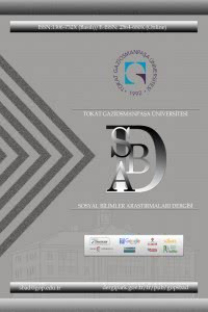ÜRETİM YAPAN İŞLETMELERİN AÇIK ÜRETİM BAKIMINDAN İNCELENMESİ: ERZURUM İLİ ÖRNEĞİ
Bu çalışmada açık üretim sistemi ve temel prensipleri açıklanarak Erzurum‟da faaliyet gösteren işletmelerin açık üretim sisteminin temel prensiplerine sahiplik düzeyleri belirlenmeye çalışılmıştır. Bu amaçla anket formu hazırlanmış ve 71 işletmenin yöneticilerine anket uygulanmıştır. Elde edilen veriler SPSS 21.0 paket programı kullanılarak analiz edilmiş ve elde edilen sonuçlar yorumlanmıştır. Çalışma sonucunda, Erzurum‟da faaliyet gösteren ve üretim yapan işletmelerin çoğunluğunun inşaat sektöründe faaliyet gösterdiği görülmektedir. İşletmeler, organizasyon içi iletişimin dönüşümü, kaliteli ürün üretebilme, modüler ürün üretebilme, üretim ile bilgi ve projelerin müşterilere açılması gibi açık üretim özellikleri bakımdan iyi seviyede iken işletmelerin, birden fazla alanda konumlanması, rekabete karşı işletme içi ve işletme dışında iş birliği yapabilme, aynı ve farklı sektörlerdeki işletmelerle birlikte karma rekabet avantajı yaratma yönünden zayıf durumda oldukları söylenebilir. Diğer açık üretim özellikleri açısından ise işletmelerin orta seviyede olduğu ifade edilebilir..
Anahtar Kelimeler:
Açık Üretim, Üretim Yönetimi
MANUFACTURING COMPANIES EXAMINED in TERMS of OPEN PRODUCTION in ERZURUM
In this study, explaining the basic principles of open production system and that plants fundamental principles of reconfigurable manufacturing system to determine the levels of ownership were studied in the Erzurum and questionnaire study has done with 71 business manager. The results are evaluated and analized with SPSS 21.0 package software. At the result of study many part of manufacturing companies which operate in Erzurum, work on construction business. The manufacturing companies seem in good-state with cycle of organizational communication, production of modular and high quality producs, opening of proction projects and informations for customers however this companies showing weak level in terms of located in more than one area, ability to collaborate inside and outside of business, creating combined competitive advantage together with same and different sectors companies. Also another restructured features level are medium.
Keywords:
Open Production, Operations Management.,
___
- Bajewa, G. S. (1994) “An Open Control İnterface For Multi-Axis Manufacturing Entites” Arizona State University S, 38.
- Basmer, S.; Buxbaum-Conradi, S.; Krenz, P.; Redlich, T.; Wulfsberg, J.P.; Bruhns, F.L. (2015) “Open Production: Chances for Social Sustainability in Manufacturing” Institute of Production Engineering, Helmut Schmidt University, 46-51.
- Giorgos, C. (2009) “From open source to open content: Organization, licensing and decision processes in open cultural production” Decision Support Systems, 47, 229–244.
- Halfaker, A. (2013) “Maintaining Efficiency in Open Production Systems at Scale A Case Study of Wikipedia” The University Of Minnesota S.3.
- Lomi, A.; Conaldi, G.; Tonellato, M.; Pallotti, F. (2014) “Participation motifs and the emergence of organization in open productions” Structural Change and Economic Dynamics 29, 40–57.
- Sanchez, F. A. C.; Boudaoud, H.; Muller, L.; Camargo, M.; (2014) “ Towards a Standard Experimental Protocol For Open Source Additive Manufacturing” Virtual and Physical Prototyping, 9, 151-167.
- Parida V.; Oghazi P.; Ericson A.; (2014) “Realization of Open Innovation: A Case Study in the Manufacturing Industry” Journal of Promotion Management, 20:372–389.
- Wulfsberg, J.P.; Redlich, T.; Bruhns, F.L.; (2011) “Open production: scientific foundation for co-creative product realization” Prod. Eng. Res. Devel. 5:127–139.
- ISSN: 1306-732X
- Yayın Aralığı: Yılda 2 Sayı
- Başlangıç: 2006
- Yayıncı: Gaziosmanpaşa Üniversitesi Sosyal Bilimler Enstitüsü
Sayıdaki Diğer Makaleler
YILDIZ RAMAZANOĞLU'NUN HİKÂYE KİŞİLERİ
TOKAT MÜZESİ'NDEKİ BİR GRUP CAM ESER; PRİZMAL GÖVDELİ ŞİŞELER
ERKEN YENİÇAĞDA HRİSTİYAN BATI DÜNYASINDA TÜRK İMAJI
YAZAR VE İDEOLOJİ: TEBRİZLİ YAZAR SAMED BEHRENGÎ'DEN DELİ DUMRUL, KELOĞLAN, KÖROĞLU
ÜRETİM YAPAN İŞLETMELERİN AÇIK ÜRETİM BAKIMINDAN İNCELENMESİ: ERZURUM İLİ ÖRNEĞİ
MEHMET AKİF İNAN’IN MEDENİYET TASAVVURU VE ŞİİRLERİNDE GELENEĞİN YENİDEN İNŞASI
RUM EYALETİ EVLATLIK VAKIFLARINDAN BİR ÖRNEK: ABDÜLVEHHAB OĞULLARI EVLATLIK VAKFI
